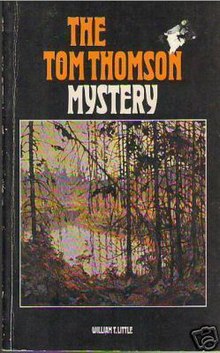 | |
| Author | William T. Little |
|---|---|
| Language | English |
| Publisher | McGraw-Hill Ryerson |
Publication date | 1970 |
| Publication place | Canada |
| ISBN | 0-07-092655-7 |
The Tom Thomson Mystery is a book by Canadian judge William T. Little. It was published in 1970 by McGraw-Hill Ryerson.[1][2][3]
Tom Thomson is regarded by some as Canada's most famous painter. He died in July 1917, drowning in Canoe Lake in Ontario's Algonquin Park, and was buried there. Two days later, his family sent an undertaker to exhume the body and send it back for re-burial in Leith, Ontario. In October 1956, Little and some friends decided to dig up Thomson's original burial place at Canoe Lake.
The book tells the story of Thomson's life and the discovery made by Little and his friends.
Little's book is one of several that raised the mystery of Tom Thomson’s death to public prominence in the late 1960s/early 1970s.
References
[edit]- ^ Holmes, Kristy A. (2010). "Imagining and Visualizing "Indianness" in Trudeauvian Canada: Joyce Wieland's "The Far Shore and True Patriot Love"". RACAR: revue d'art canadienne / Canadian Art Review. 35 (2): 47–64. ISSN 0315-9906. JSTOR 42631308.
- ^ Gessell, Paul (October 2018). "Who Killed Tom Thomson?: The Truth about the Murder of One of the 20th Century's Most Famous Artists". Quill & Quire. 84 (8): 37–37.
- ^ Grace, Sherrill; Sugars, Cynthia (April 2005). "Habeas Corpus: The Afterlife of Tom Thomson". Books in Canada. 34 (3): 26–27.

Well, that’s interesting to know that Psilotum nudum are known as whisk ferns. Psilotum nudum is the commoner species of the two. While the P. flaccidum is a rare species and is found in the tropical islands. Both the species are usually epiphytic in habit and grow upon tree ferns. These species may also be terrestrial and grow in humus or in the crevices of the rocks.
View the detailed Guide of Psilotum nudum: Detailed Study Of Psilotum Nudum (Whisk Fern), Classification, Anatomy, Reproduction